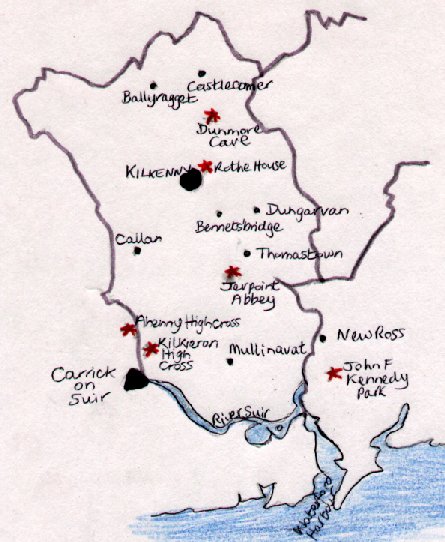|
| Duiske Abbey
Founded in 1207, Duiske abbey is the largest Cistercian church in Ireland. Outside there are two granite 9th century crosses. The inside has a great oak roof, bits of medieval pavement and a wonderful Romanesque door on the south transept. Dunmore Cave These limestone caves with their impressive formations are north of Kilkenny city, and are open to the public. Jerpoint Abbey Jerpoint abbey is one of the finest examples of Cistercian ruins in Ireland. It was founded in 1160 and flourished until the dissolution of the Monasteries when it was given to the Earl of Ormonde. The cloisters date from the 15th century and are the highlight of Jerpoint despite the fact that they have not survived as well as other, older parts have. The church is Irish-Romanesque and date back to the oldest period. There are many tombs, some of them dating to the 16th century with wonderful carvings on them. Kilkenny
In the 13th century the Irish Parliament often met in Kilkenny Castle which
is when the city became important. The Butler family, who were
Anglo-Normans came to power in the 1390's and held importance here for 500
years. Kilkenny is proud of its heritage and many of the buildings
have been renovated. The city hall, or "Tholsel" dates from the 18th century
and has a distinctive clock tower. It dominates the main high street.
the Georgian chamber is still used by city councillors. Black Abbey This Dominican Abbey was built in 1225. It was used briefly as a courtroom in the 16th century but is now a working monastery again. There are some beautiful stained glass windows, some dating back as far as the 14th century and also some fine stonework. Butter Slip This is one of Kilkenny's many alleyways which date from medieval times. This one is named after the product once sold from the stalls here-butter! Several other "slips" are being restored. Grace's Castle This building dates from 1210 and was later used as a jail. In the 18th century it was remodelled and has been used as a courthouse ever since. Kilkenny Castle Kilkenny Castle is one of Ireland's most famous castles. Built in Norman times, in the 1190's, it is set overlooking the River Nore. It was occupied up until 1935. The Butler family lived in it from the late 14th century, but due to high running costs they denoted it to the Nation in 1967. The dining room has wood panelling, there is a library and a chinese bedroom. The best room in the house however is The Long Gallery, which was rebuilt in the 1820's and has a 19th century hammer beam and glass roof. Outside there are classical French gardens with terraces opening onto a woodland walk and parkland. Kilkenny Design Centre The design centre is housed in the former stables of Kilkenny Castle. Here you can see craftspeople at work and have a chance to buy their wares. Kyteler's Inn Named after Dame Alice Kyteler who lived in the building in the 14th century. She was believed to be a witch. This is a medieval coaching inn which also sells Smithwick's beer, brewed in Kilkenny since 1710. Rothe House This building contains a museum with historical costumes and archaeological finds from the local area. The building itself is interesting. It is a tudor merchants house, fronted with arcades and once typical of Kilkenny's main street. The Shee Almshouse This is one of only a handful of Irish Tudor Almshouses to survive in Ireland. It houses the Cityscope exhibition which explains what life was like in the city in the 17th century. St Canice's Cathedral The Cathedral was built in the 13th century in an early English gothic style. Cromwell's troops sacked it in 1650 but it has still managed to survive as a medieval treasure. Its inside boasts sandstone pillars and marble walls. There is a carved west door, and many 16th century tombs with effigies. |
